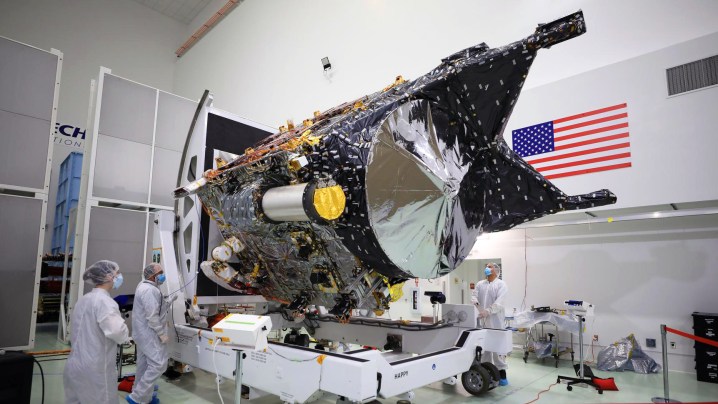یک آزمایش آزمایشی از ارتباطات لیزری سواری همراه با مأموریت Psyche، اولین دادههای خود را در نمایشی از استفاده از ارتباطات لیزری برای مأموریتهای اعماق فضا ارسال کرده است. را ارتباطات نوری فضای عمیقیا آزمایش DSOC، به فضاپیمای Psyche متصل است، که در حال حاضر پس از پرتاب ماه گذشته به سمت یک سیارک در کمربند اصلی بین مریخ و مشتری می رود.
ارتباطات برای ماموریتهای فضای عمیق ناسا توسط شبکه فضایی عمیق، شبکهای از آنتنها در سه مکان در سراسر جهان که عمدتاً از رادیو استفاده میکنند، انجام میشود. اما ارتباطات لیزری می تواند ۱۰ تا ۱۰۰ برابر پهنای باند ارائه دهد، بنابراین ناسا می خواهد با استفاده از این فناوری در موقعیت هایی مانند انتقال داده های علمی آزمایش کند.
DSOC دادههای آزمایشی را از فاصله نزدیک به ۱۰ میلیون مایل در ۱۴ نوامبر مخابره کرد و آنها را از طریق لیزر به رصدخانه پالومار مؤسسه فناوری کالیفرنیا در شهرستان سن دیگو، کالیفرنیا فرستاد. از این انتقال به عنوان “نور اول” ماموریت یاد می شود.
«دستیابی به اولین نور یکی از بسیاری از نقاط عطف حیاتی DSOC در ماههای آینده است که راه را به سوی ارتباطات با نرخ دادهای بالاتر که قادر به ارسال اطلاعات علمی، تصاویر با وضوح بالا و پخش ویدیو در حمایت از جهش عظیم بعدی بشریت است، هموار میکند: ارسال انسان. به مریخ بیانیه.
این آزمایش دشوارتر از استفاده از امواج رادیویی برای برقراری ارتباط است، زیرا امواج رادیویی در حین حرکت در یک منطقه بزرگ پخش می شوند و گرفتن آنها را آسان تر می کند. با ارتباطات لیزری، یک پرتو باریک وجود دارد، بنابراین فضاپیما و امکانات زمینی باید با دقت در یک راستا قرار گیرند.
“[The test was the first to fully incorporate the ground assets and flight transceiver, requiring the DSOC and Psyche operations teams to work in tandem,” said Meera Srinivasan, operations lead for DSOC at NASA’s Jet Propulsion Laboratory. “It was a formidable challenge, and we have a lot more work to do, but for a short time, we were able to transmit, receive, and decode some data.”
The DSOC experiment will continue for another two years, primarily using test data, but potentially sending back data from the Psyche spacecraft as well (Psyche is also equipped with traditional radio communications, so this would be purely a test of the functionality). If the system proves reliable, laser communications could help missions send large amounts of science data back to Earth in the future.
“Optical communication is a boon for scientists and researchers who always want more from their space missions, and will enable human exploration of deep space,” said Dr. Jason Mitchell, director of the Advanced Communications and Navigation Technologies Division within NASA’s Space Communications and Navigation (SCaN) program. “More data means more discoveries.”
Editors’ Recommendations
-
NASA’s first asteroid-sampling mission continues on to a new target -
NASA’s Psyche mission launches to explore a metal asteroid -
Weather conditions are looking good for today’s Psyche launch -
Measure twice, laser once. Meet the scientists prodding NASA’s first asteroid sample -
NASA’s asteroid-bound Psyche mission faces possible delay
DSOC transmitted test data from nearly 10 million miles away on November 14, sending it via laser to the California Institute of Technology’s Palomar Observatory in San Diego County, California. This transmission is referred to as the mission’s “first light.”
منبع: https://www.digitaltrends.com/space/nasa-dsoc-first-light/
